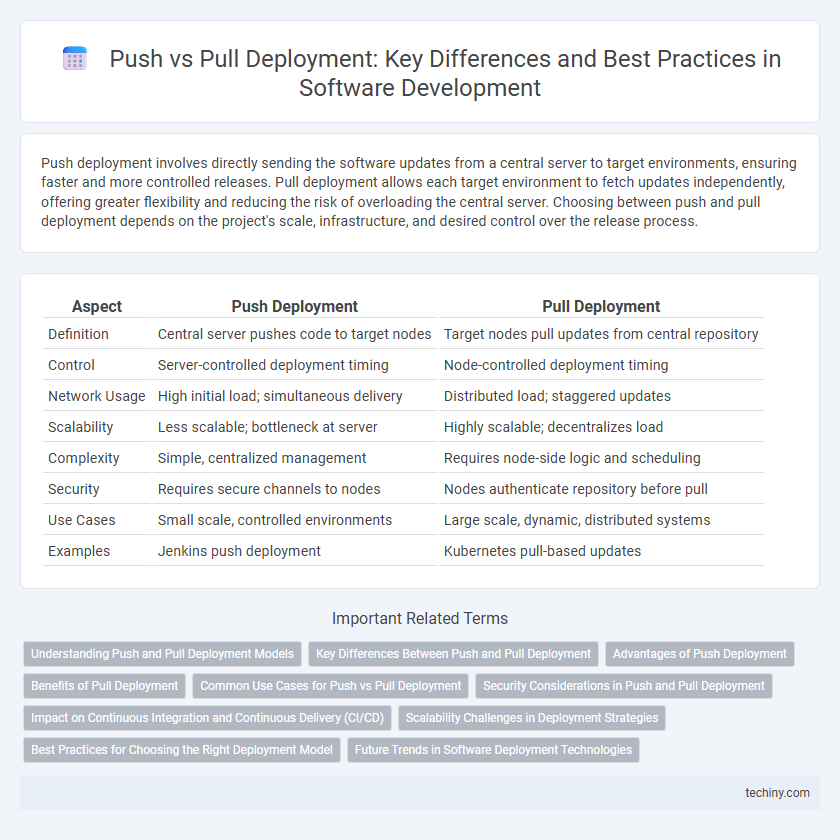Push deployment involves directly sending the software updates from a central server to target environments, ensuring faster and more controlled releases. Pull deployment allows each target environment to fetch updates independently, offering greater flexibility and reducing the risk of overloading the central server. Choosing between push and pull deployment depends on the project's scale, infrastructure, and desired control over the release process.
Table of Comparison
| Aspect | Push Deployment | Pull Deployment |
|---|---|---|
| Definition | Central server pushes code to target nodes | Target nodes pull updates from central repository |
| Control | Server-controlled deployment timing | Node-controlled deployment timing |
| Network Usage | High initial load; simultaneous delivery | Distributed load; staggered updates |
| Scalability | Less scalable; bottleneck at server | Highly scalable; decentralizes load |
| Complexity | Simple, centralized management | Requires node-side logic and scheduling |
| Security | Requires secure channels to nodes | Nodes authenticate repository before pull |
| Use Cases | Small scale, controlled environments | Large scale, dynamic, distributed systems |
| Examples | Jenkins push deployment | Kubernetes pull-based updates |
Understanding Push and Pull Deployment Models
Push deployment initiates software updates from a central server, actively sending changes to client environments, ensuring controlled and consistent releases across multiple systems. Pull deployment requires each client to independently request and retrieve updates from a repository, enabling decentralized management and reducing server load. Understanding these models is crucial for selecting deployment strategies that optimize scalability, control, and network efficiency in software development workflows.
Key Differences Between Push and Pull Deployment
Push deployment involves sending code directly from a central CI/CD server to target environments, ensuring rapid and controlled releases. Pull deployment requires target servers to fetch and apply updates autonomously, promoting decentralization and reducing direct server access risks. Key differences include control flow direction, security considerations, and update frequency management in continuous integration pipelines.
Advantages of Push Deployment
Push deployment offers seamless control and automation by allowing updates to be centrally managed and distributed to multiple servers simultaneously. It reduces manual intervention and minimizes deployment errors, enhancing overall efficiency in continuous integration and delivery pipelines. This method ensures faster rollouts and easier rollback capabilities, which are essential for maintaining system stability in agile software development environments.
Benefits of Pull Deployment
Pull deployment enables more secure and scalable software delivery by allowing target environments to request updates autonomously, reducing the risk of unauthorized access and deployment errors. This approach minimizes network dependencies and improves deployment consistency, as each environment controls when and how updates are applied, leading to better fault isolation and rollback capabilities. Enterprises benefit from enhanced audit trails and compliance management since pull deployment logs all update activities from the client side.
Common Use Cases for Push vs Pull Deployment
Push deployment is commonly used in continuous integration and delivery pipelines where automated tools deploy code directly from a central server to target environments, ensuring rapid updates and centralized control. Pull deployment suits environments with multiple distributed agents, such as IoT devices or edge servers, where each node fetches updates at scheduled intervals or on demand, reducing network load and enhancing security. Hybrid models appear in complex enterprises combining push for critical updates and pull for routine maintenance to balance control and scalability.
Security Considerations in Push and Pull Deployment
Push deployment requires secure authentication and authorization mechanisms to prevent unauthorized code execution on target servers, emphasizing the need for encrypted communication channels like SSH or TLS. Pull deployment reduces risk by allowing servers to fetch approved updates from a trusted repository, minimizing direct access exposure and limiting attack surfaces. Both methods demand rigorous audit logging and vulnerability assessments to ensure integrity and prevent deployment-stage security breaches.
Impact on Continuous Integration and Continuous Delivery (CI/CD)
Push deployment accelerates Continuous Integration and Continuous Delivery (CI/CD) pipelines by automating direct code deployment to production environments, reducing manual intervention and deployment latency. Pull deployment enhances system stability and security in CI/CD by enabling target environments to request updates, facilitating controlled and validated code integration. Both methods impact CI/CD workflows differently, with push deployment favoring speed and pull deployment emphasizing deployment precision and environment consistency.
Scalability Challenges in Deployment Strategies
Push deployment faces scalability challenges due to server overload risks when simultaneously updating numerous nodes, leading to network congestion and increased failure rates. Pull deployment enhances scalability by allowing nodes to independently retrieve updates, reducing centralized bottlenecks but requiring efficient synchronization mechanisms to prevent version inconsistencies. Effective deployment strategies balance load distribution and update coordination to maintain system reliability and performance in large-scale software environments.
Best Practices for Choosing the Right Deployment Model
Push deployment offers centralized control and faster rollouts by actively sending updates from a central server to target environments, making it ideal for tightly coordinated releases. Pull deployment enables autonomous servers to fetch updates at their own pace, enhancing scalability and reducing network congestion, which suits distributed or cloud-native infrastructures. Evaluating factors like environment complexity, update frequency, and rollback capabilities helps determine the optimal deployment model for reliability and efficiency.
Future Trends in Software Deployment Technologies
Push deployment methods, where updates are automatically sent from a central server to client environments, will evolve with AI-driven automation to enhance efficiency and minimize downtime. Pull deployment, relying on clients to request updates, will increasingly integrate edge computing for real-time, decentralized delivery, improving scalability and reducing latency. Future software deployment technologies will leverage hybrid models combining push and pull strategies, supported by containerization and orchestration tools like Kubernetes for optimized continuous delivery pipelines.
Push vs Pull Deployment Infographic

 techiny.com
techiny.com